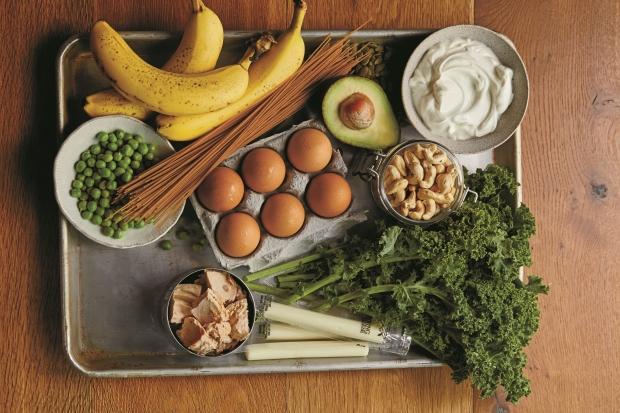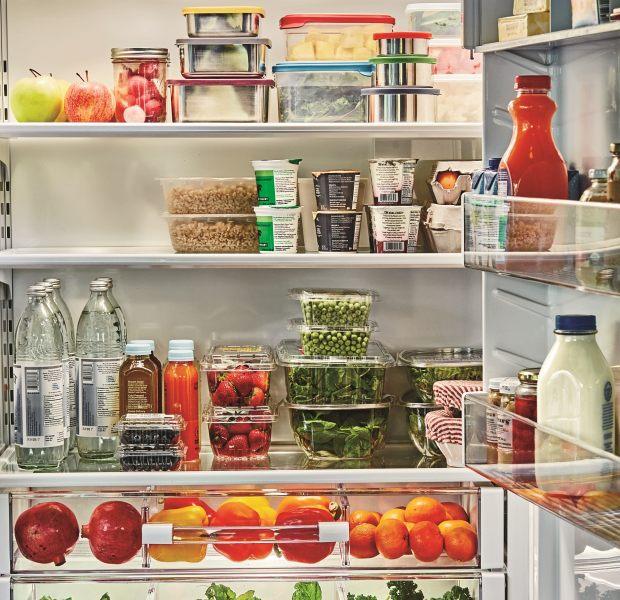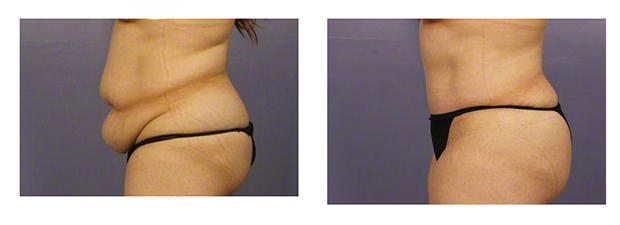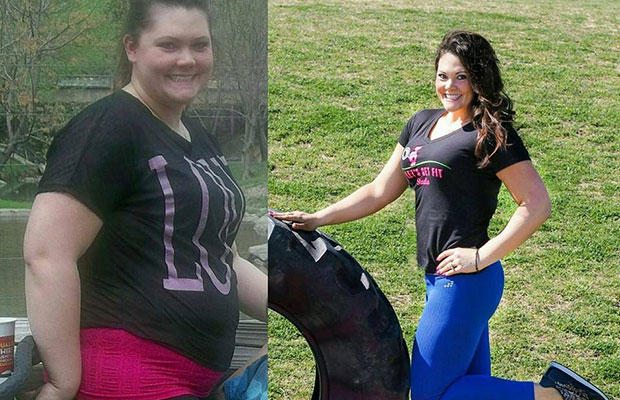Twenty-one days in, Landon was delighted. Not because she lost a few pounds—she'd done that dieting plenty of times. It was that she felt liberated from anxiety surrounding her weight. She'd replaced that miserable mix of deprivation, guilt, food shaming, and fear of failure with mindfulness skills. Finally, she didn't feel at war with her food.
 Photograph by Jason Varney
Photograph by Jason Varney
Now, 6 months after incorporating intuitive eating into her life, Landon has busted through her plateau. And this time, she's certain that the 60 pounds she's lost are never coming back. Her healthy new shape is sustainable.
Seventy-five percent of us overeat, but not because we're hungry. We do it because we're bored, stressed, lonely, addicted, or looking for support. This 21-Day Challenge to Take Control of Your Eating & Never Diet Again will train you away from mindless eating and toward psychological awareness.
"I still eat ice cream—or anything, really," Landon says now. "But instead of doing it in an empty apartment, I walk to the ice cream shop with a friend once a week. I'm enjoying my treat but pairing it with what I really need—a connection with people."
 Photograph by Jason Varney
Photograph by Jason Varney
Intuitive eating replaces dieting, which separates you from your body and forces you to abide by the diet's rules, with learning to be in touch with what your body truly needs. When you eat, you tune in to the sights, smells, textures, and tastes of food so you can enjoy eating and feel more satisfied with less. And when you feel lonely, that will be a prompt to reach for companionship, not food.
"Making big changes in your life can feel very isolating if you're doing it alone," says Landon. "If you can connect with supportive people, it's going to make a huge positive impact."
The 2-step way to make intuitive eating work for you
Step 1
Sign up for our 21-Day Challenge to Take Control of Your Eating & Never Diet Again ($9.99) starting Jan. 1, and get actionable daily lessons that make intuitive eating second nature.
Step 2
Start the process now with the four strategies outlined below—they'll help you set up your body, home, mind, and support network so that you're guaranteed success.
Here, we've outlined four key strategies to set you up for intuitive eating success. Start the year with them, then grab all the support and guidance you need by joining our 21-day online challenge.
1. Prepare Your Body
Fight deficiencies to curb overeating
About 90% of us are deficient in at least one essential nutrient, which can cause cravings for everything from chocolate to curly fries. How to tell if you're low? Only a blood test is definitive, but cravings are a red flag. While you can supplement, eating your daily quota is better. Here are six common nutrient deficiencies and how to eat to beat hunger.
Calcium and magnesium
Craving: Sweet or salty
Food fix: Get the recommended daily calcium (1,000 mg) and magnesium (320 mg) with 1 cup cooked spinach, 2 bone-in sardines, 2 oz almonds, a plain Greek yogurt, a sweet potato with skin, and 1 oz cheese.
B Vitamins
Craving: Sweet or salty
Food fix: B vitamins are found in many foods, but in varying quantities and not always together. Eating the following would give you a good mix: animal protein such as beef, salmon, or yogurt; green veggies, beans, or lentils; and sweet potatoes, winter squash, sunflower seeds, avocado, or bananas.
Zinc
Craving: Sweet or salty
Food fix: This mineral is high only in certain proteins like oysters, crab, liver, and dark chicken meat; it's found to a lesser extent in eggs, legumes, and nuts. To get your daily 8 mg, eat a 3 oz pork chop, 1/2 cup black beans, 1 oz cashews, and 1 cup cooked oatmeal.
Iron
Craving: Fatty meat
Food fix: Beef, poultry, and fish have the most absorbable iron, but you can also increase levels by eating dried fruits, cashews, pumpkin seeds, legumes, and iron-enriched pastas and grains. Hit your 8 mg daily quota (if you're over age 51) with 3 oz beef and 1 cup white beans, or 18 mg daily (if you're under age 51) with an additional 1 cup boiled spinach and a medium baked potato. (Here are 6 weird signs you're not getting enough iron.)
Omega-3s
Craving: Cheese
Food fix: Some experts recommend consuming around 500 mg daily of omega-3s. Reach that number with two servings of fatty fish like salmon, sardines, and canned tuna per week.
34% That's how much less likely people who practice intuitive habits are to be obese, compared with those with less mindfulness, according to a new study in the International Journal of Behavioral Medicine.
 Photograph by Jason Varney
Photograph by Jason Varney
Stop eating this three-flavor combo: Foods that contain sugar, salt, and fat together are rarely found in nature, yet the trio is pervasive in processed items—and can be as addictive as street drugs, triggering a dopamine release that gets you hooked and wreaks health havoc, says Gary Wenk, a professor of psychology and neuroscience at Ohio State University and Medical Center. But research shows it can take as little as 18 days to break a junk-food habit—so our challenge will help curb your addiction.
Create multi-macronutrient meals: A major cause of overeating is low blood sugar, says registered dietitian Jessica Levinson. Keep yours in check all day by ensuring snacks contain at least two macronutrients (protein, carbs, or fat)—unsweetened yogurt with nuts is a good pick—and your meals combine all three macronutrients, like salmon and brown rice with veggies roasted in olive oil. (Try one of these savory yogurt recipes to give your craving a no-sugar kick.) Carbs can fill you up and prevent overeating when they're high in fiber and low in sugar, like vegetables and unrefined whole grains such as barley, quinoa, or farro. You may also need to eat more frequently, as Landon discovered, to prevent blood sugar from getting low. Her happy place: eating every 3 hours.
21 lb This is how much more women who keep processed cereal on their countertops weigh, compared with those who keep it stored out of sight, according to recent research.
2. Shuffle Your Kitchen
A cluttered kitchen, visible leftovers, and processed food in your pantry can make you more likely to pack on pounds—so much so that Brian Wansink of Cornell University wrote the book Slim by Design: Mindless Eating Solutions for Everyday Life about simple tweaks you can make to your home to eat healthier and more intuitively with minimal effort. Here are five to try today:
 Photograph by Jason Varney
Photograph by Jason Varney
Rearrange: You're three times more likely to eat the first food you see than the fifth. So move veggies out of the crisper and onto the top shelf, put oats in the front of your pantry and cookies in the back, and clear counters of processed foods to make room for fruit.
Make your kitchen less "loungeable": The more time you spend in your kitchen, the more you tend to eat. Comfy chairs? Swap them out. Watch Netflix on your iPad at the kitchen island? Make a no-tech rule. Also keep your kitchen free of socializing—that's what the living room is for.
Make it easier to cook healthy: Cooking gives you control over the quality of what you eat and time to connect with your food. You're also more likely to make an occasion out of a home-cooked meal—sitting down at the dining room table, lighting candles, spending time with family, and eating more slowly—than if you just get greasy takeout. How to encourage cooking? Clear counter spaces and ensure easy access to blenders, pots and pans, and knives that make it easier to prep whole foods.
Shrink cups, plates, and utensils: Wansink's research shows we eat 92% of what we serve ourselves, regardless of how hungry we are—and the bigger the cup, plate, or utensil, the more food we pile on. (Here's what healthy portions of your favorite foods acutally looks like.) Prevent the supersize effect by using plates no more than 10 inches in diameter (you'll save 60 calories per meal, compared with a 12-inch plate), dessert spoons and salad forks, and tall, narrow glasses that give the appearance of being large while holding less.
Cover leftovers with foil or store in opaque containers: The "out of sight, out of mind" maxim applies to leftovers, too.
3. Rethink Your Food
Almost all of us share deeply ingrained notions that certain foods are "good" or "bad." But these words imply a moral judgment, says Susan Albers, a clinical psychologist at Cleveland Clinic and author of Eating Mindfully. "When you eat a 'bad' food, it can make you feel like you've been bad. This usually triggers shame and guilt and can send you on a stress-eating spiral." Instead, look at foods along a spectrum of "healthier" to "less healthy." Yes, you can still eat cake from time to time, but when you do, take the time to enjoy its taste, texture, and smell instead of beating yourself up about it. This way, you're more likely to feel satisfied and pay better attention to when you're full. Stop punishing yourself for what you eat, even if you overindulge, which causes many to throw in the towel and keep overeating. Instead, breathe and tell yourself that each decision going forward is an opportunity for progress.
4. Join the Movement
Ready to take control of your eating? Head to RodaleU.com/takecontrol and sign up for the 21-Day Challenge to Take Control of Your Eating & Never Diet Again, which gives you a practical lesson in intuitive eating every day, along with meditations, yoga poses, breathing exercises, and stress-busting recipes, to help you make intuitive eating a habit. "Changing your behavior kicks everything into motion," says Landon. "Sure, you need to understand the 'why' to an extent, but you also need to just do it!"




